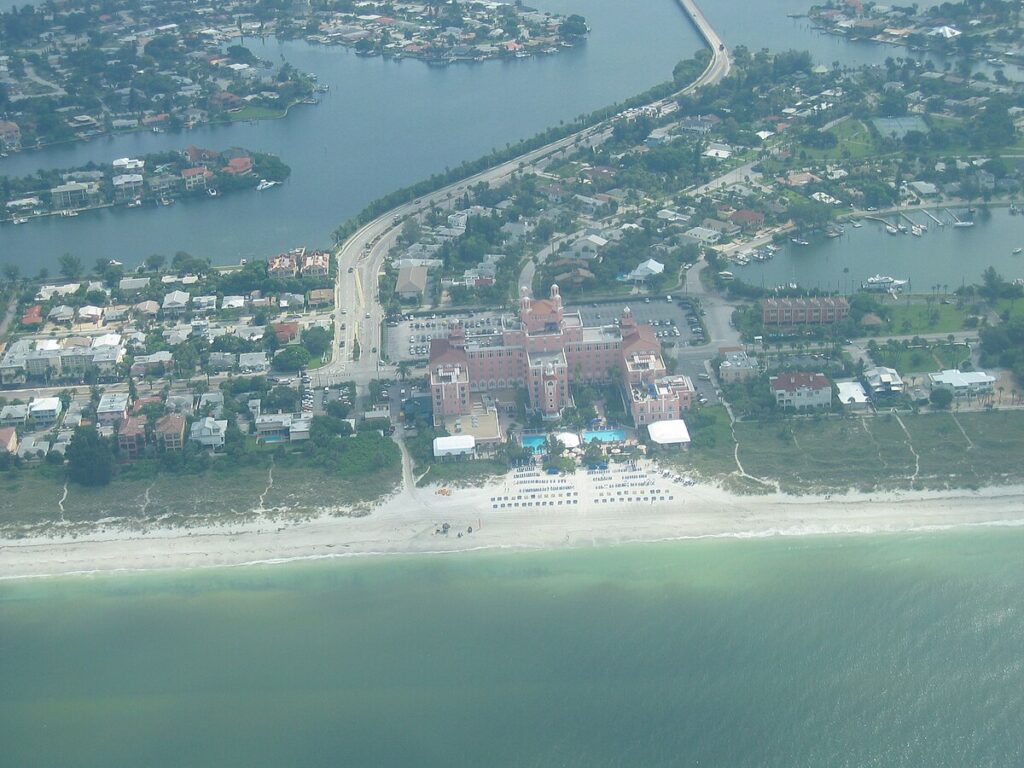
Moving to St. Pete Beach, Florida: A Comprehensive Relocation Guide
Considering moving to St. Pete Beach, Florida? This barrier island city offers award-winning beaches, resort atmosphere, and Gulf Coast lifestyle. With approximately 9,500 residents in 2025, St. Pete Beach combines beach town character with upscale amenities and Tampa Bay area access.
Demographic Profile to Consider If Moving to St. Pete Beach:
St. Pete Beach’s 2025 population is approximately 9,500 permanent residents on this barrier island in Pinellas County, though the area swells with tourists. The median age is around 54 years, with retirees, hospitality workers, and affluent second-home owners. The population is approximately 88% White, 8% Hispanic. St. Pete Beach features resort hotels, beachfront condominiums, beach houses, and the iconic Don CeSar Hotel dominating the skyline. The city stretches along beautiful Gulf of Mexico beaches consistently ranked among America’s best. St. Pete Beach attracts those seeking beachfront lifestyle, tourism employment, and resort atmosphere. The community balances tourism economy with residential character. Find trusted local services for moving, living, and working in St Pete Beach.St Pete Beach Relocation Directory
Cost of Living to Consider If Moving to St. Pete Beach:
St. Pete Beach represents premium pricing for Gulf Coast beachfront. Median home values range from $600,000 to $1 million+ in 2025, with direct beachfront properties commanding significantly more. The median household income is approximately $70,000. Rental properties average $2,500 to $4,500 monthly, with vacation rental markets affecting availability. Florida’s lack of state income tax provides benefit. Overall cost of living reflects beachfront location and resort character. St. Pete Beach attracts affluent retirees, successful professionals, and those prioritizing beach lifestyle. Housing costs create exclusivity while service workers face affordability challenges. The combination of award-winning beaches, resort amenities, and Tampa Bay access justifies premium pricing.
Economy and Job Market:
St. Pete Beach’s economy revolves entirely around tourism and hospitality. Major employers include resort hotels like the Don CeSar, TradeWinds Island Resorts, and numerous beachfront restaurants and shops. The tourism industry employs most working residents in hospitality, food service, and beach-related businesses. Real estate and property management sectors serve vacation rental and second-home markets. Many residents are retirees. Some commute to St. Petersburg for professional employment. The seasonal tourism creates employment fluctuations. The economy depends on tourist dollars with peak winter season determining income for many.
Education:
Pinellas County Schools serves St. Pete Beach students, with children typically attending schools in nearby areas. The small permanent population includes limited school-age children. The educational infrastructure focuses on mainland Pinellas County.
Recreation and Lifestyle:
St. Pete Beach offers spectacular Gulf of Mexico beaches consistently ranked among America’s best, with white sand and calm turquoise waters. The city features resort amenities including beachfront hotels, restaurants, and water sports operators. Residents enjoy swimming, beach volleyball, paddleboarding, and fishing. Upham Beach and Pass-a-Grille Beach provide different beach experiences. The area hosts beach festivals and events. The lifestyle centers entirely on beach culture, water activities, and resort atmosphere. The subtropical climate enables perpetual beach season. The community embraces tourism while maintaining residential identity. Living on the beach means accepting crowds, traffic during peak season, and tourism-focused economy. The reward is waking steps from award-winning shores daily.
Healthcare and Services:
St. Pete Beach residents access healthcare through nearby hospitals in St. Petersburg and Pinellas County including Bayfront Health St. Petersburg and numerous medical facilities. The Tampa Bay area’s extensive healthcare infrastructure provides comprehensive medical care accessible via short drives.
Transportation:
St. Pete Beach is accessed via the Corey Causeway and Pinellas Bayway connecting to mainland St. Petersburg. Tampa International Airport is approximately 40 minutes north. Pinellas Suncoast Transit Authority (PSTA) operates bus routes. Most residents use personal vehicles, though some use bicycles or walk given the compact island. Traffic congestion occurs during tourist season. Parking can be challenging.
Conclusion:
Moving to St. Pete Beach in 2025 offers Gulf Coast island living with award-winning beaches, resort atmosphere, and perpetual vacation lifestyle. The city’s combination of consistently top-rated shores, beachfront amenities, and Tampa Bay access makes it ideal for affluent beach lovers, retirees, and those seeking Florida’s premier Gulf Coast destination where every day feels like vacation and paradise is home.

